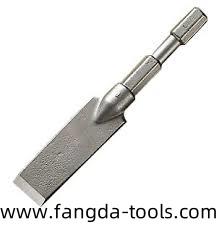Categories
Tags
Archives
How Fangda Steel Chisel Shapes Stone with Precision?
-
Every strike of a hammer carries within it the memory of transformation, and the Steel Chisel is the bridge between raw material and refined structure. Within Fangda, this simple tool is born from a science that fuses metallurgy with geometry, turning steel into an extension of human intention. The balance between hardness and resilience is not merely mechanical—it is philosophical.
The making of a chisel begins in the furnace, where temperature governs destiny. Steel is heated until its crystalline structure loosens, allowing carbon atoms to shift within the lattice. At the right moment, the metal is quenched, freezing its molecular form into hardness. This transformation defines the cutting edge's durability. Yet, a tool that is too hard becomes brittle. To avoid fracture, the process continues into tempering, where controlled reheating relaxes internal tension. This delicate equilibrium—hard enough to cut, yet flexible enough to endure—is the silent wisdom of the forge.
Composition matters as much as process. The type of steel determines not only performance but also purpose. High-carbon variants deliver superior sharpness, while alloys infused with chromium or vanadium enhance corrosion resistance and strength. Each blend is chosen according to application, ensuring that the chisel will respond consistently under pressure. Metallurgy is not merely chemistry; it is the language of endurance written in atomic rhythm.
Once forged, the chisel evolves from potential to purpose. In construction, it becomes an extension of architecture's strength. When breaking concrete, carving stone, or shaping brick, it channels human force into ordered impact. The energy of each blow is distributed through its hardened spine, allowing precision to coexist with power. The geometry of the blade—the bevel angle, edge taper, and cross-sectional symmetry—determines how material yields, not through violence but through guided fracture.
In the hands of a mason, the chisel is not a blunt instrument but an interpreter of surface and depth. The craftsman reads the texture of stone, adjusting strike and rhythm accordingly. Each tap, each echo, carries a dialogue between material resistance and mechanical patience. The artistry lies not in aggression but in alignment—when the edge meets the grain at the perfect angle, stone surrenders its shape with elegance.
The same principle applies in industrial construction. Large-scale demolition and restoration demand tools that can survive shock, vibration, and heat without deformation. Here, material science meets practical endurance. A well-tempered chisel transfers kinetic energy efficiently while minimizing rebound and wear. The geometry becomes a language of precision engineering—a silent partnership between physics and craft.
Even in modern infrastructure, where machinery dominates, the chisel remains irreplaceable in finishing, detailing, and repair. It accesses spaces where machines cannot reach, carrying with it the authenticity of human craftsmanship. It transforms rough surfaces into deliberate design, uniting the permanence of stone with the precision of steel.
This union between fire and form, between material science and artistry, defines the legacy of industrial tools. The chisel is not simply an accessory of labor—it is the physical embodiment of understanding. Every impact tells a story of thermal cycles, molecular alignment, and mechanical faith.The journey of steel, from molten potential to finished blade, mirrors the discipline of creation itself. It is forged by heat, shaped by rhythm, and perfected through control. In this balance between nature and human vision lies the foundation of durability and grace.Each tool crafted by Fangda carries this philosophy forward, merging science with purpose, endurance with design. Discover the strength and refinement within every Steel Chisel at https://www.fangda-tools.com/product/steel-chisels/
